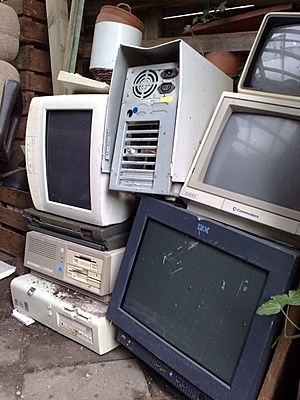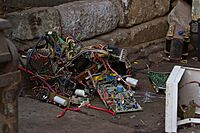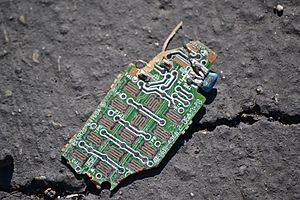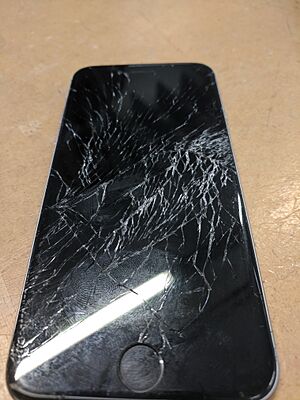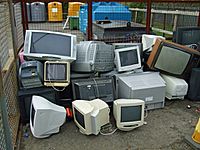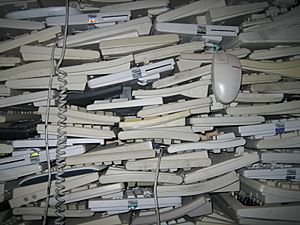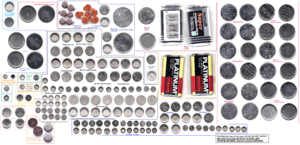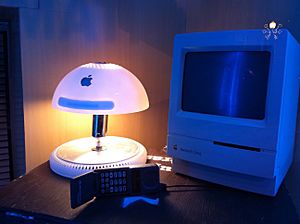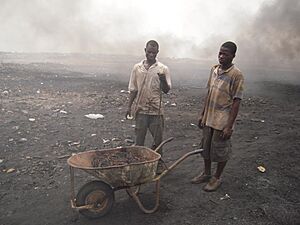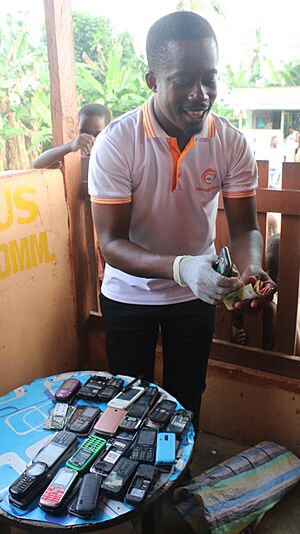Electronic waste facts for kids
Electronic waste (or e-waste) describes discarded electrical or electronic devices. It is also commonly known as waste electrical and electronic equipment (WEEE) or end-of-life (EOL) electronics. Used electronics which are destined for refurbishment, reuse, resale, salvage recycling through material recovery, or disposal are also considered e-waste.
Contents
Definition
E-waste or electronic waste is created when an electronic product is discarded after the end of its useful life. The rapid expansion of technology and the consumption driven society results in the creation of a very large amount of e-waste.
In the US, the United States Environmental Protection Agency (EPA) classifies e-waste into ten categories:
- Large household appliances, including cooling and freezing appliances
- Small household appliances
- IT equipment, including monitors
- Consumer electronics, including televisions
- Lamps and luminaires
- Toys
- Tools
- Medical devices
- Monitoring and control instruments
- Automatic dispensers
These include used electronics which are destined for reuse, resale, salvage, recycling, or disposal as well as re-usables (working and repairable electronics) and secondary raw materials (copper, steel, plastic, or similar). The term "waste" is reserved for residue or material which is dumped by the buyer rather than recycled, including residue from reuse and recycling operations, because loads of surplus electronics are frequently commingled (good, recyclable, and non-recyclable). Several public policy advocates apply the term "e-waste" and "e-scrap" broadly to apply to all surplus electronics. Cathode ray tubes (CRTs) are considered one of the hardest types to recycle.
Using a different set of categories, the Partnership on Measuring ICT for Development defines e-waste in six categories:
- Temperature exchange equipment (such as air conditioners, freezers)
- Screens, monitors (TVs, laptops)
- Lamps (LED lamps, for example)
- Large equipment (washing machines, electric stoves)
- Small equipment (microwaves, electric shavers)
- Small IT and telecommunication equipment (such as mobile phones, printers)
Quantity
E-waste is considered the "fastest-growing waste stream in the world" with 44.7 million tonnes generated in 2016 - equivalent to 4500 Eiffel towers. In 2018, an estimated 50 million tonnes of e-waste was reported, thus the name 'tsunami of e-waste' given by the UN. Its value is at least $62.5 billion annually.
Rapid changes in technology, changes in media (tapes, software, MP3), falling prices, and planned obsolescence have resulted in electronic waste piling up around the globe.
Society today revolves around technology and by the constant need for the newest and most high-tech products we are contributing to a mass amount of e-waste. Since the invention of the iPhone, cell phones have become the top source of e-waste products.
Bitcoin mining has also contributed to higher amounts in electronic waste. Estimates indicate that the bitcoin network discards as much "small IT and telecommunication equipment waste produced by a country like the Netherlands," totalling to 30.7 metric kilotons every year.
In 2021, an estimated of 57.4 Mt of e-waste was generated globally. According to estimates in Europe, where the problem is best studied, 11 of 72 electronic items in an average household are no longer in use or broken. Annually per citizen, another 4 to 5 kg of unused electrical and electronic products are hoarded in Europe prior to being discarded. In 2021, less than 20 percent of the e-waste is collected and recycled.
In 2022, an increase of 3.4% was estimated of the generated e-waste globally, hitting 59.4Mt, which made the total unrecycled e-waste on earth to 2022 is over 347 Mt.
Guiyu
Guiyu in the Guangdong region of China is a massive electronic waste processing community. It is often referred to as the "e-waste capital of the world." Traditionally, Guiyu was an agricultural community; however, in the mid-1990s it transformed into an e-waste recycling center involving over 75% of the local households and an additional 100,000 migrant workers. Thousands of individual workshops employ laborers to snip cables, pry chips from circuit boards, grind plastic computer cases into particles, and dip circuit boards in acid baths to dissolve the precious metals. Others work to strip insulation from all wiring in an attempt to salvage tiny amounts of copper wire. Uncontrolled burning, disassembly, and disposal has led to a number of environmental problems such as groundwater contamination, atmospheric pollution, and water pollution either by immediate discharge or from surface runoff (especially near coastal areas), as well as health problems including occupational safety and health effects among those directly and indirectly involved, due to the methods of processing the waste.
Six of the many villages in Guiyu specialize in circuit-board disassembly, seven in plastics and metals reprocessing, and two in wire and cable disassembly. Greenpeace, an environmental group, sampled dust, soil, river sediment, and groundwater in Guiyu. They found very high levels of toxic heavy metals and organic contaminants in both places. Lai Yun, a campaigner for the group found "over 10 poisonous metals, such as lead, mercury, and cadmium."
Guiyu is only one example of digital dumps but similar places can be found across the world in Nigeria, Ghana, and India.
Environmental impact
Informal processing of e-waste in developing countries can lead to adverse human health effects and environmental pollution.
Liquid and atmospheric releases end up in bodies of water, groundwater, soil, and air and therefore in land and sea animals – both domesticated and wild, in crops eaten by both animals and humans, and in drinking water.
One study of environmental effects in Guiyu, China found the following:
- Airborne dioxins – one type found at 100 times levels previously measured
- Levels of carcinogens in duck ponds and rice paddies exceeded international standards for agricultural areas and cadmium, copper, nickel, and lead levels in rice paddies were above international standards
- Heavy metals found in road dust – lead over 300 times that of a control village's road dust and copper over 100 times
Electronic waste substances
Electrical waste contains hazardous but also valuable and scarce materials. Up to 60 elements can be found in complex electronics. Concentration of metals within the electronic waste is generally higher than a typical ore, such as copper, aluminium, iron, gold, silver, and palladium.
Electronic scrap components, such as CPUs, contain potentially harmful materials such as lead, cadmium, beryllium, or brominated flame retardants. Recycling and disposal of e-waste may involve significant risk to the health of workers and their communities.
Hazardous
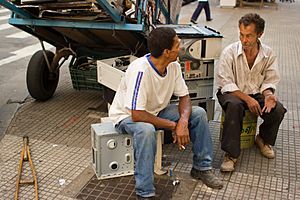
| E-waste Component | Electric Appliances in which they are found | Adverse Health Effects |
|---|---|---|
| Americium | The radioactive source in smoke alarms. | It is known to be carcinogenic. |
| Lead | Solder, CRT monitor glass, lead–acid batteries, some formulations of PVC. A typical 15-inch cathode ray tube may contain 1.5 pounds of lead, but other CRTs have been estimated as having up to 8 pounds of lead. | Adverse effects of lead exposure include impaired cognitive function, behavioral disturbances, attention deficits, hyperactivity, conduct problems, and lower IQ. These effects are most damaging to children whose developing nervous systems are very susceptible to damage caused by lead, cadmium, and mercury. |
| Mercury | Found in fluorescent tubes (numerous applications), tilt switches (mechanical doorbells, thermostats), and ccfl backlights in flat screen monitors. | Health effects include sensory impairment, dermatitis, memory loss, and muscle weakness. Exposure in-utero causes fetal deficits in motor function, attention, and verbal domains. Environmental effects in animals include death, reduced fertility, and slower growth and development. |
| Cadmium | Found in light-sensitive resistors, corrosion-resistant alloys for marine and aviation environments, and nickel–cadmium batteries. The most common form of cadmium is found in nickel–cadmium rechargeable batteries. These batteries tend to contain between 6 and 18% cadmium. The sale of nickel–cadmium batteries has been banned in the EU except for medical use. When not properly recycled it can leach into the soil, harming microorganisms and disrupting the soil ecosystem. Exposure is caused by proximity to hazardous waste sites and factories and workers in the metal refining industry. | The inhalation of cadmium can cause severe damage to the lungs and is also known to cause kidney damage. Cadmium is also associated with deficits in cognition, learning, behavior, and neuromotor skills in children. |
| Hexavalent chromium | Used in metal coatings to protect from corrosion. | A known carcinogen after occupational inhalation exposure.
There is also evidence of cytotoxic and genotoxic effects of some chemicals, which have been shown to inhibit cell proliferation, cause cell membrane lesion, cause DNA single-strand breaks, and elevate Reactive Oxygen Species (ROS) levels. |
| Sulfur | Found in lead–acid batteries. | Health effects include liver damage, kidney damage, heart damage, eye and throat irritation. When released into the environment, it can create sulfuric acid through sulfur dioxide. |
| Brominated Flame Retardants (BFRs) | Used as flame retardants in plastics in most electronics. Includes PBBs, PBDE, DecaBDE, OctaBDE, PentaBDE. | Health effects include impaired development of the nervous system, thyroid problems, liver problems. Environmental effects: similar effects as in animals as humans. PBBs were banned from 1973 to 1977 on. PCBs were banned during the 1980s. |
| Perfluorooctanoic acid (PFOA) | Used as an antistatic additive in industrial applications and found in electronics, also found in non-stick cookware (PTFE). PFOAs are formed synthetically through environmental degradation. | Studies in mice have found the following health effects: Hepatotoxicity, developmental toxicity, immunotoxicity, hormonal effects and carcinogenic effects. Studies have found increased maternal PFOA levels to be associated with an increased risk of miscarriage and stillbirth. Increased maternal levels of PFOA are also associated with decreases in mean gestational age (preterm birth), mean birth weight (low birth weight), mean birth length (small for gestational age), and mean APGAR score. |
| Beryllium oxide | Filler in some thermal interface materials such as thermal grease used on heatsinks for CPUs and power transistors, magnetrons, X-ray-transparent ceramic windows, heat transfer fins in vacuum tubes, and gas lasers. | Occupational exposures associated with lung cancer, other common adverse health effects are beryllium sensitization, chronic beryllium disease, and acute beryllium disease. |
| Polyvinyl chloride (PVC) | Commonly found in electronics and is typically used as insulation for electrical cables. | In the manufacturing phase, toxic and hazardous raw material, including dioxins are released. PVC such as chlorine tend to bioaccumulate. Over time, the compounds that contain chlorine can become pollutants in the air, water, and soil. This poses a problem as human and animals can ingest them. Additionally, exposure to toxins can result in reproductive and developmental health effects. |
Generally non-hazardous
| E-waste component | Process used |
|---|---|
| Aluminum | Nearly all electronic goods using more than a few watts of power (heatsinks), ICs, electrolytic capacitors |
| Copper | Copper wire, printed circuit board tracks, ICs, component leads |
| Germanium | 1950s–1960s transistorized electronics (bipolar junction transistors) |
| Gold | Connector plating, primarily in computer equipment |
| Lithium | Lithium-ion batteries |
| Nickel | Nickel–cadmium batteries |
| Silicon | Glass, transistors, ICs, printed circuit boards |
| Tin | Solder, coatings on component leads |
| Zinc | Plating for steel parts |
Human health and safety
Residents living near recycling sites
Residents living around the e-waste recycling sites, even if they do not involve in e-waste recycling activities, can also face the environmental exposure due to the food, water, and environmental contamination caused by e-waste, because they can easily contact to e-waste contaminated air, water, soil, dust, and food sources. In general, there are three main exposure pathways: inhalation, ingestion, and dermal contact.
Studies show that people living around e-waste recycling sites have a higher daily intake of heavy metals and a more serious body burden. Potential health risks include mental health, impaired cognitive function, and general physical health damage (see also Electronic waste#Hazardous). DNA damage was also found more prevalent in all the e-waste exposed populations (i.e. adults, children, and neonates) than the populations in the control area. DNA breaks can increase the likelihood of wrong replication and thus mutation, as well as lead to cancer if the damage is to a tumor suppressor gene.
Children
Children are especially sensitive to e-waste exposure because of several reasons.
Exposure to e-waste can cause serious health problems to children. Children's exposure to toxins containing in e-waste can lead to a higher risk of lower IQ, impaired cognitive function, exposure to known human carcinogens and other adverse effects. In certain age groups, a decreased lung function of children in e-waste recycling sites has been found. Some studies also found associations between children's e-waste exposure and impaired coagulation, hearing loss, and decreased vaccine antibody tilters in e-waste recycling area.
E-waste recycling workers
The complex composition and improper handling of e-waste adversely affect human health.
The Occupational Safety & Health Administration (OSHA) has summarized several potential safety hazards of recycling workers in general, such as crushing hazards, hazardous energy released, and toxic metals.
| Hazards | Details |
|---|---|
| Slips, trips, and falls | They can happen during collecting and transporting e-waste. |
| Crushing hazards | Workers can be stuck or crushed by the machine or the e-waste. There can be traffic accidents when transporting e-waste. Using machines that have moving parts, such as conveyors and rolling machines can also cause crush accidents, leading to amputations, crushed fingers or hands. |
| Hazardous energy released | Unexpected machine startup can cause death or injury to workers. This can happen during the installation, maintenance, or repair of machines, equipment, processes, or systems. |
| Cuts and lacerations | Hands or body injuries and eye injuries can occur when dismantling e-waste that has sharp edges. |
| Noise | Working overtime near loud noises from drilling, hammering, and other tools that can make a great noise lead to hearing loss. |
| Toxic chemicals (dusts) | Burning e-waste to extract metals emits toxic chemicals (e.g. PAHs, lead) from e-waste to the air, which can be inhaled or ingested by workers at recycling sites. This can lead to illness from toxic chemicals. |
Information security
Discarded data processing equipment may still contain readable data that may be considered sensitive to the previous users of the device. A recycling plan for such equipment can support information security by ensuring proper steps are followed to erase the sensitive information. This may include such steps as re-formatting of storage media and overwriting with random data to make data unrecoverable, or even physical destruction of media.
Recycling
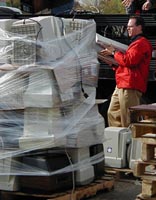
Recycling is an essential element of e-waste management. Properly carried out, it should greatly reduce the leakage of toxic materials into the environment. However, it does need to be encouraged by local authorities and through community education. Less than 20% of e-waste is prorerly recycled, with 80% either ending up in landfill or being informally recycled – much of it by hand in developing countries, exposing workers to hazardous and carcinogenic substances such as mercury, lead and cadmium.
Consumer awareness efforts
Some U.S. retailers offer opportunities for consumer recycling of discarded electronic devices. In the US, the Consumer Electronics Association (CEA) urges consumers to dispose properly of end-of-life electronics through its recycling locator. CEA research has found that 58 percent of consumers know where to take their end-of-life electronics, and the electronics industry would very much like to see that level of awareness increase. Consumer electronics manufacturers and retailers sponsor or operate more than 5,000 recycling locations nationwide and have vowed to recycle one billion pounds annually by 2016, a sharp increase from 300 million pounds industry recycled in 2010.
See also
 In Spanish: Chatarra electrónica para niños
In Spanish: Chatarra electrónica para niños


